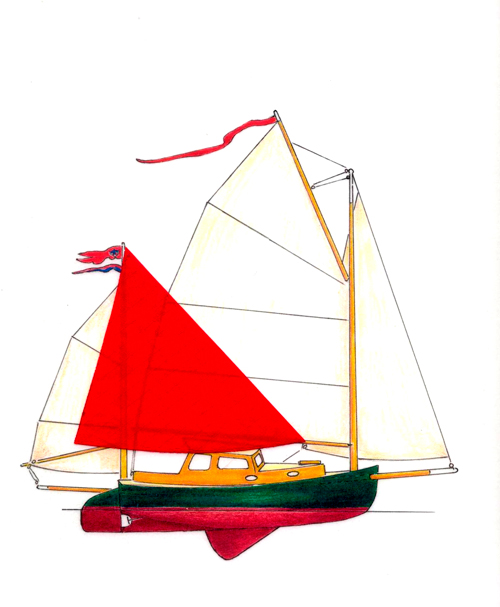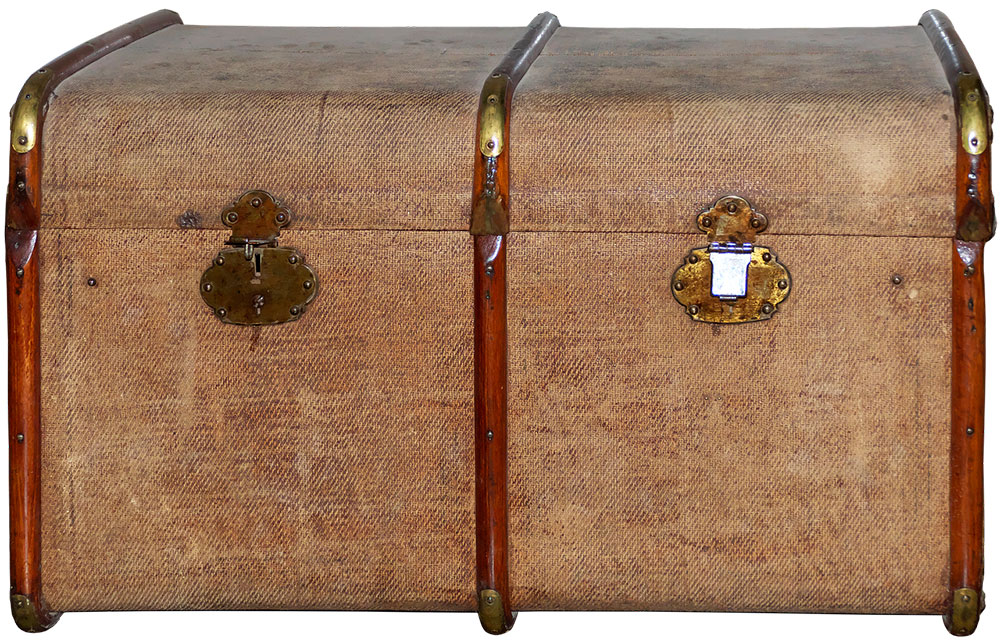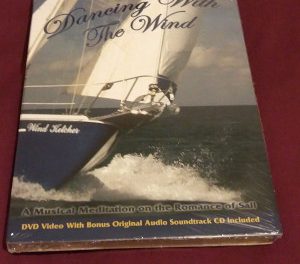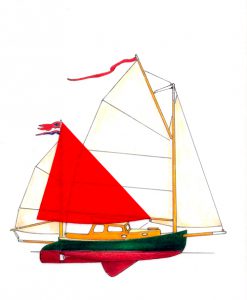
The Muskrat’s little sister and forerunner Dabbler, ex Marshall 18 Sanderling
When we retired from full-time cruising and built a house on the shores of the Chesapeake Bay, my wife Dee and I bought a thoroughly dilapidated 1966 Marshall 18 Sanderling catboat for exploring the Bay’s shallow waters. We used brutal methods to give her a complete makeover. The result was a cat yawl with a permanent doghouse, easy chairs, a small galley, and a woodstove (“Good Old Catboat,” September 2001). We called her the Dabbler, and explored much of the lower Chesapeake in her.
In due course fate thrust into our hands an equally dilapidated 1971 Marshall 22 catboat. A neighbor was moving to the mountains. Would we, “as a favor, at a distress price . . .” Well, our bodies were getting a bit creaky, and a bigger, beamier, heavier-displacement version of Dabbler sounded like a wonderful idea.
We dubbed her Muskrat, parked her next to our house in the woods, and proceeded to transmogrify her, somewhat.
The grittiest work was ridding the boat of waterlogged and rotted plywood components that had been tabbed to the hull with polyester resin and tapes without any protection from wicking up water. This turned out to include the cockpit and cabin soles and their underpinnings and the lower portions of the main cabin and forepeak bulkheads. As we removed these basic structural components with saws, pry bars, hammers, and chisels, we scribed the needed shapes off onto new CDX ply. I used an angle grinder to clean up the hull where the replacements would sit. We coated the new pieces with epoxy resin and bedded in thickened epoxy. Generous filets and layers of tape and resin guaranteed a strong and waterproof job.
With all the rotted ply replaced, we could proceed to more rewarding work:
1) Installing an improved cockpit sole, complete with engine box.
2) Fitting a new diesel.

My wife Dee’s preliminary sketch showing what we were aiming at. In the end the house was longer and lower, and the mizzen grew to a standing lugsail with a 10- foot yard.
3) Removing the aftermost part of the cabin top and covering the new space and part of the cockpit with a wood/epoxy doghouse.
4) Enhancing the interior for comfort and charm.
5) Converting the gaff cat rig to gaff yawl with jib.
The new cockpit
As we had done in Dabbler, we dropped the new cockpit sole a few inches, compensating for the loss of the questionable self-bailing feature with a big diaphragm bilge pump worked with a handle accessible while seated at the helm. (The original cockpit drained into the centerboard trunk through tiny scuppers, with no provision to rid the cockpit of water when heeled.) Now, generous scalloped cutouts outboard where the new sole is bonded to the hull drain directly into the bilge when the boat is heeled. Scuppers forward drain into the bilge when boat’s on an even keel. A fitted Sunbrella cockpit cover snaps on to keep out rain at anchor, at docks, or in the boatyard. Increased space under the seats (which, being fiberglass, we retained) allows more stowage: a second portable potty, plastic bins with engine spares, tools, safety equipment, dock lines and fenders, wood for the stove, etc. Lift-out fiddles keep everything in place.
We replaced the old Palmer gas engine with a 13.5 HP 2-cylinder Beta Marine diesel, on massive new beds, flanked by two 10-gal fuel tanks and the original 20-gal water tank. The engine box with hinged, fiddled lid makes a handy cockpit table.
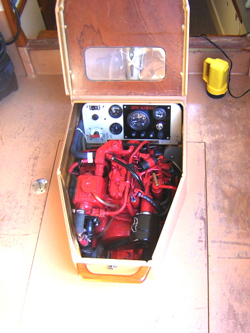
The hinged lid gives access to the Beta Marine diesel. Entire box and portion of cockpit sole lift off for engine maintenance and access to bilges. Plexiglass window lets us read gauges with lid closed.
We added a husky autopilot so we could sit under the projecting doghouse out of the wind, rain, or sun, keeping a lookout through the windows, and check the course on the GPS. The original shippy-looking spoked wheel, impractical with main and mizzen sheets wandering about in the same space, gave way to a leathered destroyer wheel.
Doghouse
With a portion of the original cabin top Sawsalled out, we designed the new house by eye (my wife Dee’s artistic eye, to give credit where due), using cheap underlayment plywood for a mockup. When she said “go” we built the real thing with marine ply and epoxy, laminating the crowned roof over the mockup. We copied the Dabbler’s removable polycarbonate window system with “eyebrows” that trap the 2mm Lexan panes and keep water out. The house at one stroke provides shelter for the cockpit and more space and light below. It weighs less than the fiberglass, hatch, and louvered teak doors we removed.
Down below
After crouching under the doghouse to step down into the cabin, a 6 footer can stand up with two inches of headroom to spare. He or she can stand up at the galley counter, stand up to handle the halyards, reefing, and furling lines that come in through fairleads in the forward face of the house, stand up to put on his or her pants, or just stand up to view the whole horizon – 360 degrees. For ventilation, any of the six polycarbonate windows can be removed from inside. The forward pair can be replaced with mosquito screen.
The cabin sole is simply outdoor carpet over transmogrified lead ballast. This was originally in 20-pound pigs, loose, under a rotten wood sole. (Loose ballast down in a deep-keel boat may be OK, but in a design with very shallow rise of floor, not so OK. We found half the pigs wedged up under the bunks instead of flanking the centerboard trunk where they belonged.) We got the pigs into the shape we wanted by melting them in a makeshift outdoor foundry composed of a cast-iron Dutch oven suspended from a tripod over a big propane burner. A long pipe handle bolted to our pot facilitated pouring the lead into a deep stainless-steel steam-table pan bedded in sand. The result was lead wedges that function as the cabin sole. This operation turned out to be easier than we imagined. A carpenter’s adjustable bevel gage, spirit level, and ruler were used to test the angles of the rise and run of the hull adjacent the centerboard trunk, and the needed thickness of each wedge.

The epoxy/marine ply doghouse was assembled in our sail loft. It was light enough for the two of us to carry through the double doors of my loft to the Muskrat, where we picked it up with the peak halyard and gaff and slung it aboard. Dee is waiting to guide it into place, to be permanently bonded with epoxy to the cabin top, sides and cockpit coamings.
Our measurements were replicated by shifting the pan in its bed of sand for each successive pour, and controlling the depth of lead with a line scribed inside the pan. The width of our “mold” dictated five wedges per side, diminishing in all dimensions from aft. Average weight turned out to be 50 pounds, so we wound up with 500 pounds of ballast, which with a 350 lb galvanized steel centerboard (installed after we found the original glass-over-plywood board warped and wedged in its trunk) gives 850 pounds, same as the standard Marshall 22. Cut-to-shape indoor-outdoor carpet fastened in place with Dot snaps makes a comfortable skid-resistant surface. Each of the ten wedges, save for two which can be lifted out to access the centerboard pin, is trapped in a bed of 5200 adhesive polyurethane. The “lead sole” gave us three extra inches of sitting legroom and standing headroom.
Because our plans for the Muskrat were comfortable fall and winter cruising, we decided to insulate the hull and overhead in the cabin and forepeak. I epoxied sawn ¾ x 1-inch spruce “ribs” to the hull and infilled with ¾-inch foam board, glued to the hull with Liquid Nails construction adhesive. Overhead, foam fills the space between the deck beams. Varnished white cedar ceiling (2 x ¼-inch laths) fastened to the ribs and beams with oval-head brass screws, completed the job. This was particularly happy work, both because the result gave us warmth and freedom from condensation, and because it hid forever the raw, rough, mildew-trapping fiberglass finish typical of these early boats. Of course the insulation is equally valuable in hot weather – especially considering Muskrat’s black hull.
Which brings us to the wood stove. We have long been fans of wood stoves. Dee and her first husband left San Diego for the Caribbean in a 36 ft ketch fitted with a cast iron FATSCO Tiny Tot. I left Chicago bound down the Mississippi in a Sea Wind ketch with a Tiny Tot. We had one on Dabbler. The Muskrat’s is a cooktop model that will boil up the coffee water while heating the cabin. To complete the cold-weather arrangements, a marine-grade automotive-type engine hot water heater, operating off the diesel’s closed cooling system, blows warm air into the cabin when under power. The big doghouse windows provide solar heat when the sun’s out.
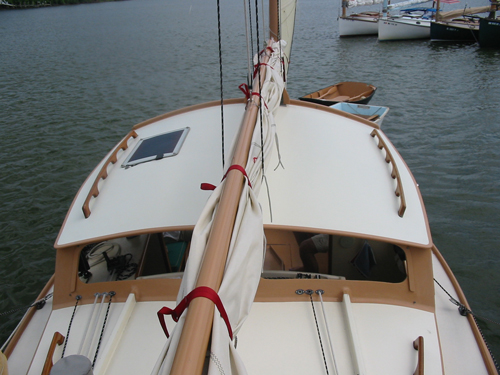
Halyards and reef pendants enter the doghouse to starboard where they can be led to a winch and controlled by sheet stoppers. To port are the jib furling line and lazy jack lift.
Up forward
The fore cabin of a 22-ft boat is not likely to amount to much. The original layout included a very narrow berth, 1 foot 8 inches at the head, 1 foot 10 inches at the foot, to port, opposite a marine toilet. Dee tried this coffin-shaped space once or twice, but did not find it a pleasurable experience. I took her word for it. Happily for us we invented a hinged, cantilevered extension that yields a full-size bunk, 2 feet 6 inches wide at the head, 2 feet at the foot, and 6 feet 3 inches long. Raising the extension allows easy access to the portable toilet. The new bunk, coupled with the insulated cedar-clad hull and overhead, transformed the forepeak into a comfortable, pleasant space. It’s the preferred berth in warm weather, being right under the forehatch. A second portable toilet in the cockpit accommodates the midnight needs of the main-cabin occupant.
The rig

3/4” foam insulation, covered with 2” varnished white cedar laths, was applied to the hull and cabin overhead in the forepeak and main cabin.
The cat yawl rig with bowsprit and bumpkin on Dabbler proved such a success we mimicked it on Muskrat. Die-hard catboaters (“only one string to pull”) will decry it as heresy, but it has too many advantages to ignore:
1) It tames the notorious catboat weather helm (tamed it almost out of existence until we made a bigger mizzen).
2) Squalls and heavy wind are met by just dropping the main.
3) Going downwind invites using the main and mizzen wing and wing. The jib can be furled or poled out opposite the main.
4) Heaving to with the jib furled and mizzen sheeted home allows setting, reefing, or striking the main with the helm untended. In a squall with sea room, the same rig with the wheel locked will let you lie to and go below for a cup of tea.
5) In moderate winds, just tack and leave the jib sheeted aback and you’re hove to and can consider options or take a lunch break.
6) Ease the mizzen broad off (the sprit boom keeps it from skying), drop the main, sheet the jib in tight, and Muskrat will self-steer herself nearly dead down wind indefinitely.
7) Furl the jib to simplify short tacking to windward, as up rivers and creeks or in a crowded anchorage. The boat will sail just as close to the wind, but a little slower.
8) With the jib furled and the main doused in the lazy jacks, leave the mizzen sheeted home when preparing to anchor – the boat will shoot straight to windward while you amble forward to ready the ground tackle. Let go the hook when she stops and the boat will gather sternway and drift straight back until the rode’s snubbed.
9) Because Muskrat anchors by the tip of her long snout and has some windage aft — the deck house and mizzen mast — she lies at anchor like an arrow, instead of shearing about restlessly like normal cats.
The spars
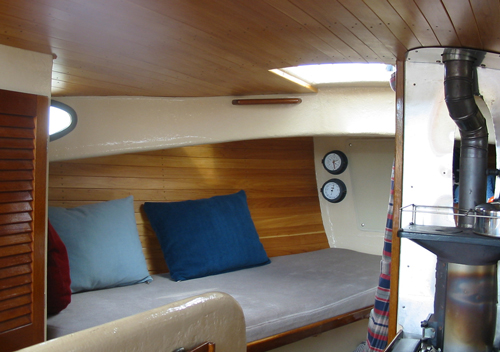
New interior with varnished ceiling on hull and overhead, Tiny Tot wood stove, carpeted sole, and the big bunk forward
The original 30-year-old aluminum mast was compromised above the partners by corrosion under fittings that were installed without bedding. The butt was split due to corrosion between it and the aluminum end casting. These were serious faults in a free-standing mast carrying a big gaff sail. Because we were planning a smaller mains’l anyway, we cut off a couple of feet at the butt and used part of the offcut as a doubler in way of partners, gooseneck fitting, turning blocks, etc. To make it big enough to do that we slit a two-foot section, slipped it over a piece of railroad track suspended between two saw horses, and wacked on it everywhere with a heavy rubber mallet until it opened up for a slip fit. We bedded it in place with Marine Tex, an aluminum-powder-thickened epoxy putty, and while clamped with big band clamps, put a few machine screws into the mast near the edges of the slit. The stainless gooseneck and the halyard turning blocks below it are fastened through both layers, bedded on Marine Tex. The mast is now stronger than new, and unlikely to suffer corrosion again.
The new spars — mizzen, bowsprit, and bumpkin — came out of two 23-foot x 4-inch diameter tapered aluminum flagpoles. The manufacturer rates these poles for winds up to 104 mph when flying a four by six foot flag. We couldn’t relate that to the probable loads on Muskrat’s rig, but Dee says they look right, so I think they probably are. The mizzen can be stepped by hand.
Muskrat’s sparred length is 34 feet, but the bumpkin can be housed (comes inboard under the port cockpit seat), and with the bowsprit unshipped the LOA is back to 22 feet 2 inches.

Nearly the best idea we had: A cantilevered bunk extension for the minimalist forward berth. The scars show where the original was tabbed to the hull and bulkhead.
The Sails
Our working sail is 459 sq ft. (compared to 388 sq ft on the stock Marshall 22). In light to moderate winds we can set a mizzen stays’l and swift along under 589 sq ft of sail.
Because I’m a sailmaker, Muskrat has had a series of sails lavished on her. We refer to her, tongue in cheek, as “the company boat” and have used her as a trial horse from the outset. The first suit of sails for the new rig included a smallish furling jib, a battened gaff main to suit the shortened mast and boom, and a battened Bermudan mizzen. These were all in 5-ounce cream Dacron. The powerful 130-sq-ft mizzen staysail is 3-ounce polyester spinnaker cloth. Within a year we made an improved main, this time with full battens. Then a bigger mizzen which, using the same mast, required resorting to a 4-sided sail. We designed a full-batten standing lug sail, which proved efficient on all points of sail, and results in just the right amount of weather helm when close hauled. After we stumbled on an antique pair of bottom-handle bronze winches and mounted them outside the cockpit comings, a bigger, overlapping, furling jib joined the team. A third full-batten gaff main, the lower two batten pockets incorporating reefs, ended Muskrat’s role as our trial horse.
Stuart Hopkins and his wife Dee (a founding member of the Seven Seas Cruising Association), spent decades as full-time cruising sailors. They now live near a Chesapeake Bay creek just deep enough for catboats. Stuart is a sailmaker specializing in traditional small craft sails (www.dabblersails.com). Dee is the author of four illustrated nautical books, including Narrow Waters, reviewed in the September l999 Good Old Boat.

